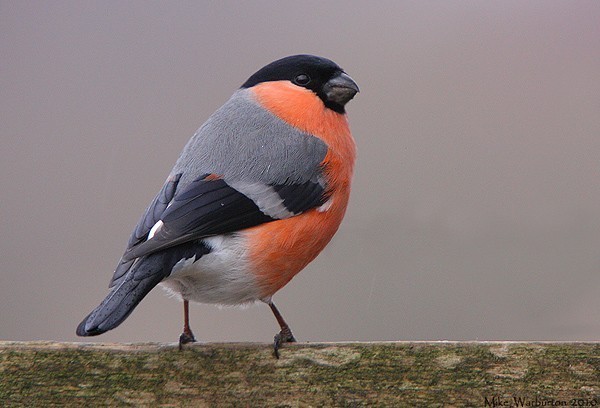In the biggest-ever analysis of songbirds and their predators, published in the Journal of Applied Ecology, scientists look at the role of predators in the decline of species such as Bullfinch and Yellowhammer. Whilst a small number of associations may suggest significant negative effects between predator and prey species, for the majority of the songbird species examined there is no evidence that increases in common avian predators or Grey Squirrels are associated with large-scale population declines.

Bullfinch, Pen-y-fan Pond CP, Gwent (Photo: Mike Warburton)
This research by Stuart Newson (BTO), Eric Rexstad (University of St Andrews), Stephen Baillie (BTO), Stephen Buckland (University of St Andrews) and Nicholas Aebischer (Game and Wildlife Conservation Trust) is published as "Population changes of avian predators and Grey Squirrels in England: is there evidence for an impact on avian prey populations?" in the British Ecological Society's Journal of Applied Ecology.
By combining detailed bird observations at over 200 sites in the period 1967–2000 with those of over 2,000 volunteers surveying sites during the period 1995–2005, the authors have been able to take forward the debate about songbirds and predators. This research, led by scientists from the British Trust for Ornithology and funded by SongBird Survival, uses information made available by partners in the Breeding Bird Survey (BTO, RSPB and JNCC).
Although it is widely accepted that, in some situations, predators of nests, chicks and full-grown birds do affect the abundance of avian prey species, until now the evidence that such effects are widespread amongst songbirds has been weak, having been based on a relatively small number of studies.

Great Spotted Woodpecker, undisclosed site, Derbyshire (Photo: Robert Askew)
In this paper, the authors look at how prey and predator numbers have changed over nearly 40 years to see if there are associations between trends for particular prey species and their predators. This is the most sophisticated, long-term and large-scale analysis of its kind ever undertaken. It examines the effects of three avian predators of juvenile and adult birds (Buzzard, Sparrowhawk and Kestrel) and of four avian and one mammalian nest predators (Great Spotted Woodpecker, Magpie, Jay, Carrion Crow and Grey Squirrel). Grey Squirrel data were only available for the period 1995–2005.
This robust study found that:
- For 22 of the 29 potential prey species examined there was no statistically significant link between the increase of predator numbers and the decline of prey numbers. Thus, for the majority of prey species examined, the study provides no evidence that population changes have resulted from changes in predator numbers.
- Amongst the seven species in which there were significant negative effects of particular predators, the relationships that are most worthy of further investigation are associations between the increase in the number of Sparrowhawks during the period 1967–2000 and declines in the abundances of Bullfinches, Tree Sparrows and Reed Buntings. These associations may help to identify priorities for future work on the effects of predation on songbird populations, inasmuch as they relate to the suite of prey species considered here.
- Across the suite of prey species covered, predator effects were negative for three species: Sparrowhawk, Kestrel and Grey Squirrel. This suggests that studies of predation by Sparrowhawks, Kestrels and perhaps also Grey Squirrel should be priorities for future work.
- There were a large number of positive associations between predators and prey, suggesting that predator numbers have largely increased as the amount of prey has increased. This is particularly the case for native avian nest predators (Great Spotted Woodpecker, Magpie, Jay and Carrion Crow). Although this largely exonerates these predators as driving declines in the numbers of songbird species at a national level, it does not preclude individual predators having local effects.

Jay, undisclosed site, Derbyshire (Photo: Robert Askew)
Dr Stuart Newson, Lead author and Senior Research Ecologist at the BTO, said: "At the heart of this piece of work is a shared concern about the decline of species such as Bullfinch and Yellowhammer. For the majority of the songbird species we examined, there was no evidence that increases in common avian predators and Grey Squirrels are associated with large-scale population declines. However, by looking at changes in predators and prey at a very large number of sites, we have identified some predator/prey relationships that may be usefully studied further. This research relies upon a huge amount of information that has been collected by thousands of BTO volunteers over a period of forty years."
Clive Sherwood, Chairman of SongBird Survival, said: "This is the first major project that we have funded and we are pleased to have worked on it with the BTO. It will take the debate forward and clarifies some priorities for future research."
This is a high-quality study based on unique long-term and large-scale datasets. This robust study found that, for the majority of the songbird species examined, there is no evidence that increases in common avian predators and Grey Squirrels are associated with large-scale depression of prey abundance or population declines. It is also clear that, for the majority of declining species with unfavourable conservation status population, declines appear to be due to factors other than predation.
Other studies have suggested that, over the period of this study, songbird population changes have been influenced by a range of other factors, most notably changes in farmland and woodland management.

